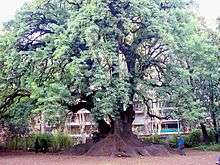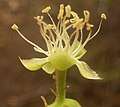Phytolacca dioica
Phytolacca dioica, commonly known as umbú, is a massive deciduous tree native to the Pampa of South America. It has an umbrella-like canopy that spreads to a diameter of 12 to 15 meters (40 to 50 feet) and can attain a height of 12 to 18 meters (40 to 60 feet). Because it is derived from herbaceous ancestors, its trunk consists of anomalous secondary thickening rather than true wood. As a result, the ombú grows fast but its wood is soft and spongy enough to be cut with a knife. These properties have led it to be used in the art of bonsai, as it is easily manipulated to create the desired effect. Since the sap is poisonous, the ombú is not grazed by cattle and is immune to locusts and other pests. For similar reasons, the leaves are sometimes used as a laxative or purgative. It is a symbol of Uruguay and Argentina, and of gaucho culture, as its canopy is quite distinguishable from afar and provides comfort and shelter from sun and rain.
| Umbú | |
|---|---|
 | |
| A specimen in Buenos Aires, Argentina, which is over 80 years old | |
| Scientific classification | |
| Kingdom: | Plantae |
| Clade: | Tracheophytes |
| Clade: | Angiosperms |
| Clade: | Eudicots |
| Order: | Caryophyllales |
| Family: | Phytolaccaceae |
| Genus: | Phytolacca |
| Species: | P. dioica |
| Binomial name | |
| Phytolacca dioica | |
| Synonyms | |
|
Pircunia dioica Moq. | |
This tree is categorized in the same genus as the North American pokeweed. The species is also cultivated in Southern California as a shade tree. Ombú has been declared as a minor invasive species (category 3) in South Africa, where it is widely planted.[1]
Gallery
- Magenta petioles and leaf venation

Flower .jpg)
Inflorescence and fruit 
Infructescence and seeds – MHNT
References
- Glen, Hugh & Van Wyk, Braam (2016) Guide to Trees introduced into South Africa. pp.232-233. Struik Nature, Cape Town